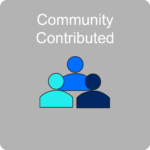Curriculum Modules

- Introduction to Systems
- Systems Are Everywhere
- Bioengineering a Sustainable World
-
Computational Modeling
- Demystifying Machine Learning
- Ecological Networks
- Environmental Influence on Gene Networks
-
Invisible Forest
Unit Plan Lesson 0.5 – It’s Only a Drop of Water (Project Based Learning Plan) Lesson 1 – A Breath of Oxygen Lesson 2 – Who’s who in the photosynthetic world from macro to microscale Lesson 3 – Tools of the Trade Exploratorium: Collecting Oceanographic Data From Where We Cannot See Lesson 3.5 Phytoplankton, Spectrophotometry & Microscopy Labs Lesson 4 – Scaling up: Linking cells in a drop of seawater to global patterns Lesson 5 – Dive into Data: Raw to Results Contributors
-
Modeling Sustainable Food Systems
Food Security Module Overview Lesson FS1: Introduction to Food Security Lesson FS2: Critically Evaluating Food Production Techniques Application: Designing, constructing, and reengineering a system Lesson FS3: Who Cares? Stakeholders! Lesson FS4: Food Security as a System Lesson FS5: Why Don’t We Just Grow More? Lesson FS6: Where Does Our Food Come From? Lesson FS7: Summative Assessment – United Nations Council Meeting Contributors
-
Observing Beyond Our Senses
Unit Plan Lesson 1 – Introduction to Saline Environments & Microbial Halophiles Lesson 2 – Design Process-Measuring Wind Speed Lesson 3 – Inferences From Proxy Variable Mock AFM Lesson 4 – Signal and Noise Lesson 5 – Inferring Properties and Calibrations Lesson 6 – Death Valley Middle Basin Case Study Contributors
-
Ocean Acidification
Unit Plan Lesson 1 – Critical and Systems Evaluation of News Articles Lesson 2 – Exploring CO2 to Better Understand Ocean Acidification Lesson 3 – Defining the Problem: Ocean Acidification Lesson 4 – Planning Cohesive Experiments Lesson 5a – Ocean Acidification Experimentation Lesson 5b – Online Data and Supplemental Evidence Lesson 5b – Online Data and Supplemental Evidence (pre-2018 version) Lesson 5c – Using Ocean Acidification Models to Make Predictions Lesson 6 – Global Ocean Acidification Summit Contributors
-
Carbon’s Fate
-
Systems Medicine Education
-
Standards Addressed
- Community-Contributed

SEE's community of educators has shared the following resources.
These can be taught with SEE modules or as part of courses with similar aims. If you have modules, lesson plans, instructional materials and/or activities that you would like to submit to be included here for the benefit of STEM teachers, please reach out to our team at SEE@isbscience.org.
Dr. Danielle Winget of Seattle Pacific University submitted three lessons from an undergraduate Sustainability and Science course.
Each lesson is designed for an 80-minute class. Please use these buttons to access a webpage that contains the objectives, activities and materials for each of these 3 lessons. Dr. Winget has also made additional lessons available covering Classes 19-28 (19: Biodiversity, 20: Habitat Loss & Remediation, 21: Modern Agriculture, 22: Irrigation, Drought & Watersheds, 23: Agriculture Alternatives & Colony Collapse Disorder, 24: Urbanization & Stormwater, 25: Social Equality & Science, 26 & 27: Campus Sustainability Projects, 28: Science & Politics). You can also access all of her lessons on this Google doc.
Class 16: Genetics Class 17: Genetically Modified Organisms Class 18: GMO Consequences
Ryan Hainey of La Cañada Flintridge, California, worked with SEE's Jessica Day to craft this Introduction to Aquaponics for students.
This was used with middle school and high school students in classrooms and after-school programs as part of Project Feed 1010.
Water Quality Testing can be an important add-on to several of our modules.
These modules include Ecological Networks, Observing Beyond our Senses, Food Security and Sustainability. These lessons by Edvotek have been recommended by our community of educators.
Water Quality Testing I Water Quality Testing II
In addition to these Community Contributed resources, teachers have also submitted SEE module curricular adaptations.
All SEE modules and content are written in editable files so that teachers can alter and/or update the materials for their students and contexts. Please see our Curriculum Adaptations page for several examples of how teachers have adapted SEE modules. Please also join our community to chat with educators and to receive help while using SEE modules in your setting. We are a strong network and are ready to help you successfully implement SEE modules! Use the social media icons at the bottom of the page, or view our social media hands through the links below.
Facebook Twitter Instagram YouTube LinkedIn

